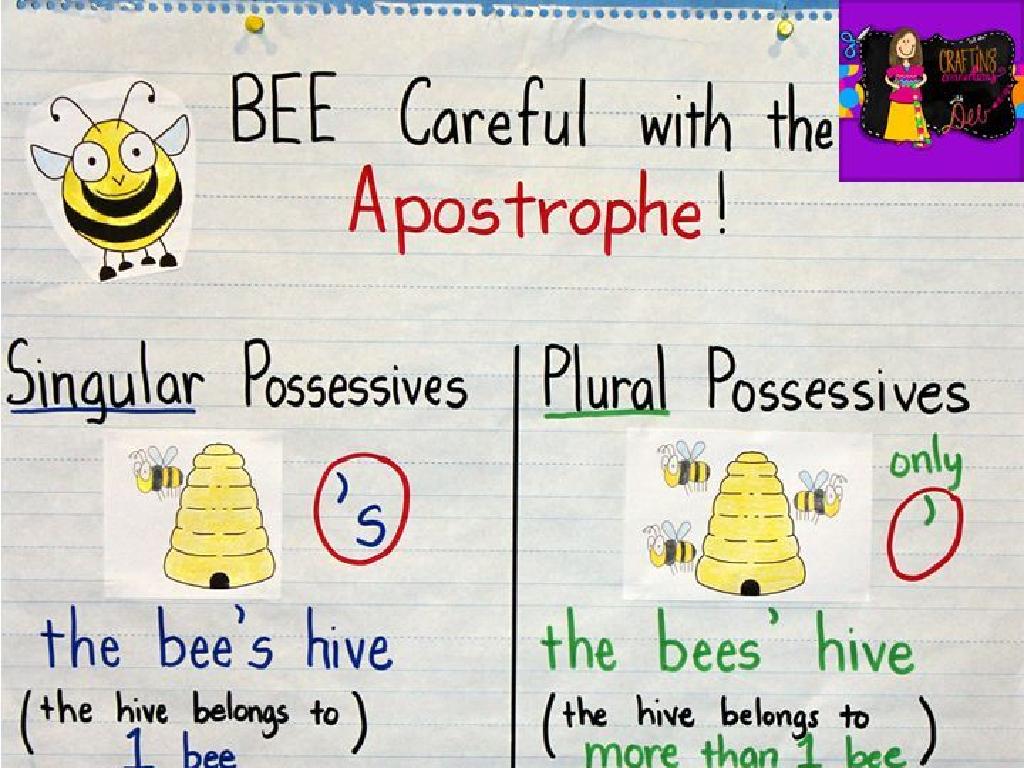Identify Mistakes Involving The Order Of Operations
Subject: Math
Grade: Fifth grade
Topic: Numerical Expressions
Please LOG IN to download the presentation. Access is available to registered users only.
View More Content
Mastering the Order of Operations
– Understanding order of operations
– It’s like a math recipe: PEMDAS (Parentheses, Exponents, Multiplication and Division, Addition and Subtraction)
– Importance of correct order
– Using the wrong order can lead to incorrect answers, just like missing a step in a recipe
– Today’s goal: Spotting errors
– We’ll learn to find and fix common mistakes when using PEMDAS
– Practice correcting mistakes
– We’ll do exercises to apply what we’ve learned and become order of operations experts
|
This slide introduces the concept of the order of operations, which is crucial for solving mathematical expressions accurately. Emphasize the acronym PEMDAS as a mnemonic to help students remember the sequence. Explain that just like steps in a recipe, each part of PEMDAS must be followed in the correct order to get the right result. Today’s class will focus on identifying common errors that occur when this order is not followed and practicing how to correct them. Provide examples of incorrect calculations and guide students through the process of finding and fixing the errors. Encourage students to ask questions and work through practice problems to reinforce their understanding.
Mastering the Order of Operations
– Understanding PEMDAS
– PEMDAS is a mnemonic for the order of operations in math.
– Order: Parentheses to Subtraction
– Start with Parentheses, then Exponents, followed by Multiplication/Division, and end with Addition/Subtraction.
– Breaking down each operation
– We’ll look at each step closely and see how it’s used in an equation.
– Practice with examples
– Example: For 3 + (4 x 2) – 5^2, solve inside parentheses (4 x 2) first, then the exponent 5^2, and so on.
|
This slide introduces the concept of the order of operations, which is crucial for solving mathematical expressions correctly. PEMDAS is a helpful mnemonic that stands for Parentheses, Exponents, Multiplication and Division, Addition and Subtraction, indicating the order in which operations should be performed. Emphasize that multiplication and division are done from left to right, as are addition and subtraction. Provide clear examples for each step, ensuring students understand that operations within parentheses take precedence and that exponents are handled before any multiplication or division. Encourage students to solve a few problems on their own to apply what they’ve learned.
Common Mistakes: Order of Operations
– Ignoring parentheses in equations
– Parentheses mean do this part first, e.g., 2 * (3 + 4) ` 2 * 3 + 4
– Confusing multiplication-division order
– Remember, multiply or divide before adding or subtracting, whichever comes first left to right.
– Mixing addition-subtraction sequence
– Add and subtract in the order they appear, from left to right.
– Skipping exponents before other operations
– Exponents are calculated before multiplication, division, addition, and subtraction.
|
This slide aims to highlight the common errors students make when applying the order of operations in mathematical expressions. Emphasize the importance of parentheses as they indicate which part of the problem to tackle first. Clarify that multiplication and division should be addressed before addition and subtraction, following the left-to-right rule. Remind students that exponents must be dealt with before any other operations. Use examples to illustrate each point and encourage students to practice with exercises that specifically target these common mistakes to reinforce their understanding.
Correcting Order of Operations Mistakes
– Spot the error in the expression
– Look at 3 + 5 x 2. Is it 16 or is it 13?
– Apply PEMDAS properly
– Remember, Parentheses, Exponents, Multiplication/Division, Addition/Subtraction
– Compare right and wrong answers
– Correct: 3 + (5 x 2) = 13. Incorrect: (3 + 5) x 2 = 16
– Understand the impact of errors
– Mistakes change the answer. Always follow PEMDAS!
|
This slide is aimed at helping students identify and correct mistakes in numerical expressions, specifically involving the order of operations. Start by presenting an expression with a common mistake, such as misunderstanding PEMDAS. Then, guide students through the correct application of the order of operations. Compare the correct and incorrect answers to highlight the importance of following the rules. Emphasize how a single mistake can lead to a completely different answer and stress the importance of careful calculation. Provide additional examples for practice and encourage students to explain their reasoning.
Practice: Order of Operations Mistakes
– Work through examples together
– Spot mistakes in order of operations
– Look for errors in PEMDAS sequence
– Correct the mistakes found
– Apply correct PEMDAS rules to fix errors
– Explain reasoning for corrections
– Discuss why the correct order is important
|
This slide is designed for a collaborative class activity where students will work together to identify and correct mistakes in the order of operations. The teacher should prepare a few examples with intentional errors in the sequence of operations. Students will be encouraged to spot the errors, correct them, and then explain why the corrections are necessary. Emphasize the importance of following the PEMDAS rule (Parentheses, Exponents, Multiplication and Division, Addition and Subtraction) to ensure accurate calculations. The teacher should guide the discussion, helping students understand that operations must be performed in the correct order to achieve the right answer. Possible activities could include peer review of work, group problem-solving, or individual correction and presentation.
Group Activity: Order of Operations
– Find mistakes in expressions
– Correct the expressions as a group
– Explain one expression to the class
– Each group picks one expression and presents the correct solution.
– Discuss importance of correct order
– Why does 2 + 3 x 4 = 14 and not 20? Let’s find out.
|
This group activity is designed to engage students in collaborative problem-solving while reinforcing the concept of the order of operations. Each group will work together to identify and correct mistakes in given mathematical expressions. After corrections, groups will choose one expression to explain their thought process to the class, fostering peer learning. Emphasize the importance of following the correct order of operations (PEMDAS/BODMAS) to achieve accurate results in mathematics. As a teacher, prepare to guide discussions and clarify misconceptions. Possible activities: 1) Matching incorrect with corrected expressions, 2) Creating a wall of common mistakes and corrections, 3) Peer-teaching a corrected expression, 4) Role-playing as ‘math detectives’ to find errors, 5) A game where groups race to correct expressions.
Individual Practice: Order of Operations
– Solve given problems independently
– Spot any possible errors made
– Apply PEMDAS to verify answers
– Remember, PEMDAS stands for Parentheses, Exponents, Multiplication and Division (from left to right), Addition and Subtraction (from left to right).
– Reflect on the importance of order
|
This slide is aimed at reinforcing the concept of the order of operations through individual practice. Students are expected to solve the problems provided, identify any mistakes they or their peers might have made, and use the PEMDAS rule to check their work. PEMDAS is a mnemonic that helps students remember the order in which they should perform operations in a mathematical expression. It’s crucial for students to understand that operations within parentheses are done first, followed by exponents, then multiplication and division from left to right, and finally addition and subtraction from left to right. Encourage students to take their time and carefully follow each step of the order of operations. As an activity, provide a mix of expressions, some correctly solved and some with intentional errors, and ask students to identify and correct the mistakes.
Class Activity: Operation Correction Game
– Become an ‘operation doctor’
– Diagnose expression errors
– Find where the order of operations was not followed
– Correct the order of operations
– Use PEMDAS to fix the mistakes
– Share your ‘operation’ success
|
In this interactive class activity, students will engage in a game called ‘Operation Correction’ where they act as ‘operation doctors’ to identify and correct mistakes in numerical expressions that do not follow the order of operations (PEMDAS). Provide each student or group with a set of expressions containing common errors. As ‘doctors,’ they will diagnose the problems and perform ‘operations’ to make the expressions correct. After correcting, students will share their corrected expressions with the class. Possible activities: 1) Individual student correction, 2) Group work to solve more complex expressions, 3) Peer review of corrected expressions, 4) Timed challenges for who can correct expressions the fastest, 5) Create their own ‘tricky’ expressions for peers to correct.
Wrapping Up: Order of Operations
– Recap the order of operations
– Remember PEMDAS: Parentheses, Exponents, Multiplication/Division, Addition/Subtraction
– Why correct order matters
– Using the wrong order can lead to incorrect answers
– Homework: Mistake-finding worksheet
– Complete the worksheet by finding and fixing errors in numerical expressions
– Practice makes perfect!
|
As we conclude today’s lesson, it’s crucial to emphasize the importance of the order of operations, commonly remembered by the acronym PEMDAS. Understanding and following this order is essential to solving math problems correctly. For homework, students will receive a worksheet with various numerical expressions where they must identify and correct mistakes related to the order of operations. This exercise will reinforce their understanding and help them avoid common errors. Encourage students to take their time with each problem and to double-check their work. Remind them that practice is key to mastering math concepts.






